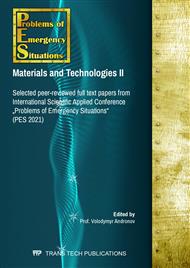[1]
Swaddiwudhipong S., Lu H., Wee T (2003). Direct tension test and tensile strain capacity of concrete at early age,Cement and Concrete Research, Vol. 33 (12), pp.2077-2084.
DOI: 10.1016/s0008-8846(03)00231-x
Google Scholar
[2]
Choi S., Yang K., Sim J, Choi B (2014). Direct tensile strength of lightweight concrete with different specimen depths and aggregate sizes, Construction and Building Materials, Vol. 63, p.132–141.
DOI: 10.1016/j.conbuildmat.2014.04.055
Google Scholar
[3]
Wee T., Lu H., Swaddiwudhipong S (2000). Tensile strain capacity of concrete under various states of stress, Magazine of Concrete Research, vol. 52 (3), pp.185-193.
DOI: 10.1680/macr.2000.52.3.185
Google Scholar
[4]
Evdokimova T. S. (2017). Napryazhenno-deformirovannoe sostoyanie i raschet prochnosti kososzhimaemy`kh fibrozhelezobetonny`kh e`lementov: dis. kandidata tekh. nauk: 05.23.01 / Evdokimova Tat`yana Sergeevna, S-Pb., 150 p.
Google Scholar
[5]
Kaprielov S. S., Chilin I. A. (2017). Sverkhvy`sokoprochny`j samouplotnyayushhijsya fibrobeton dlya monolitny`kh konstrukczij, Vestnik NICz Stroitel`stvo, Vol. 1(12), p.14 – 22.
Google Scholar
[6]
Priev B., Genina E. (2020). Issledovanie sovmestnoj raboty` betona i stalefibrobetona v dvukhslojnom sechenii pri izgibe i raskaly`vanii [Elektronnij resurs]: (e`lektronny`j sbornik statej II mezhdunar. nauch. konf.), ARKhITEKTURNO-STROITEL`NY`J KOMPLEKS: PROBLEMY`, PERSPEKTIVY`, INNOVACzII, p.104 – 112.
Google Scholar
[7]
Vasilchenko A., Otrosh Y., Adamenko N., Doronin E., Kovalov A. (2018). Feature of fire resistance calculation of steel structures with intumescent coating. MATEC Web of Conferences, 230: 02036.
DOI: 10.1051/matecconf/201823002036
Google Scholar
[8]
Tipka M., Vašková J., Vodička J. (2018). Tensile Strength Tests for Concrete and Fibre Reinforced Concrete, Solid State Phenomena, 272, pp.94-101.
DOI: 10.4028/www.scientific.net/ssp.272.94
Google Scholar
[9]
Alhussainy F., Hasan H., Sheikh M Neaz., Hadi M. N. S. (2019). A New Method for Direct Tensile Testing of Concrete. Journal of Testing and Evaluation, 47 (2), pp.704-718.
DOI: 10.1520/jte20170067
Google Scholar
[10]
Otrosh Yu., Surianinov M., Golodnov A., Starova O. (2019). Experimental and Computer Researches of Ferroconcrete Beams at High-Temperature Influences, Materials Science Forum 6th International Conference Actual Problems of Engineering Mechanics, (APEM 2019) ISSN:1662-9752, Vol. 968, pp.355-360.
DOI: 10.4028/www.scientific.net/msf.968.355
Google Scholar
[11]
Neutov S., Sydorchuk M., Surianinov M. (2019). Experimental Studies of Reinforced Concrete and Fiber-Reinforced Concrete Beams with Short-Term and Long-Term Loads, Materials Science Forum 6th International Conference Actual Problems of Engineering Mechanics, (APEM 2019), ISSN:1662-9752, Vol. 968, pp.227-233.
DOI: 10.4028/www.scientific.net/msf.968.227
Google Scholar
[12]
Surianinov M., Neutov S., Korneieva I., Sydorchuk M. (2020). Study and comparison of characteristics of models of hollow-core slabs, reinforced concrete and steel-fiber concrete, 7th International Conference on Actual problems of engineering mechanics, APEM 2020, Odesa; Ukraine, 249859 Vol. 864, pp.9-18.
DOI: 10.4028/www.scientific.net/kem.864.9
Google Scholar


